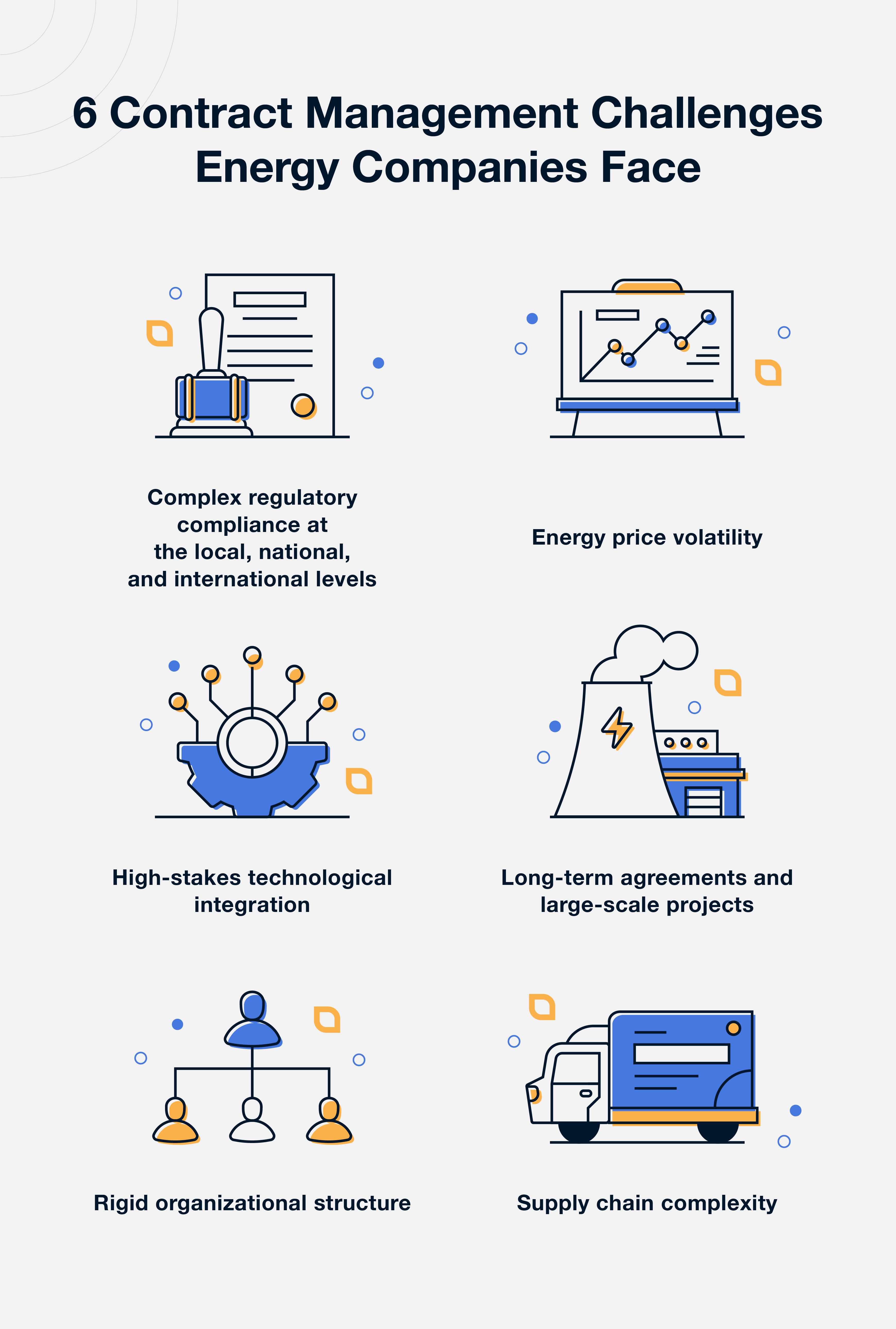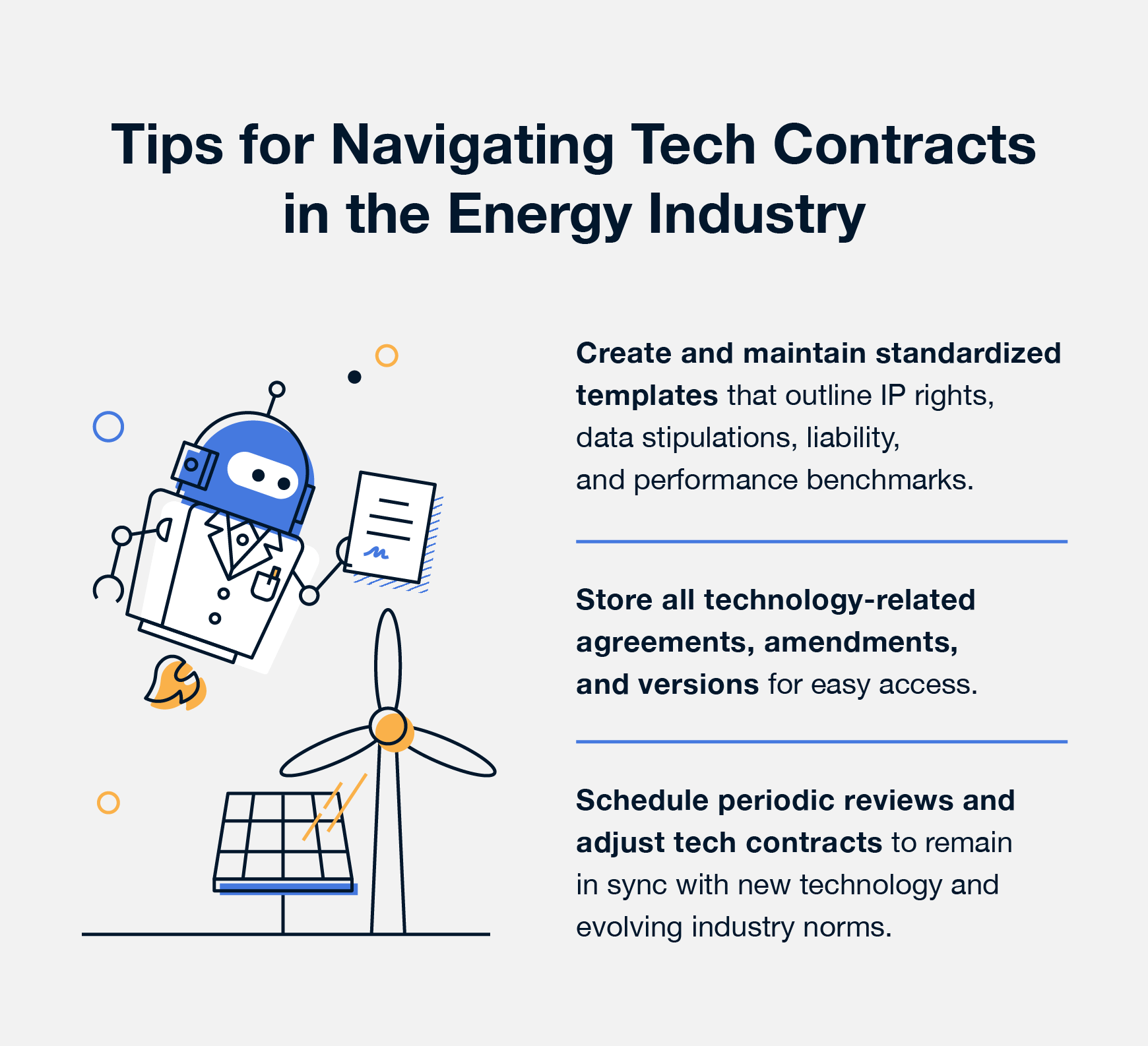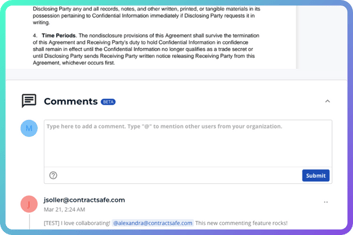Contract management is a critical backbone for energy companies. It supports the vast ecosystem spanning the production, distribution, and consumption of diverse energy sources like oil, gas, coal, renewables, and electricity.
Effective energy contract management is paramount in keeping supply chains intact, maintaining international partnerships, and ensuring compliance in an environment marked by volatility and stringent regulations.
Navigating the intricacies of energy contracts isn't an easy task, and the team behind ContractSafe knows this firsthand.
Our founders used to run a solar company, but grappled with the challenge of finding a contract management software that truly met their needs. Unable to find a satisfactory solution, they decided to build their own.
In this article, we'll delve into the contract management challenges energy companies face, from complex regulatory compliance to supply chain intricacies. We'll also shed light on best practices to manage these challenges effectively.
TL;DR
- Energy companies juggle a ton of contract management hurdles across regions and regulations.
- The stakes are particularly high, as mismanagement of key contracts could result in huge losses.
- ContractSafe can help streamline the process, making contract management more intuitive and efficient.
Common Types of Energy Contracts
Energy contracts form the backbone of operations in the sector, setting terms and ensuring smooth transactions. Let’s dive into the common types and understand why robust contract management is key in keeping the lights on:
| Contract Type | Why It Matters |
| Power purchase agreements (PPAs) | PPAs involve long-term deals between energy producers and buyers. They often feature fluctuating prices, strict delivery schedules, and specific delivery stipulations. |
| Energy supply contracts | These contracts detail the amount and timing of energy deliveries. They can specify quantities, prices, and schedules. |
| Direct access energy agreements | These agreements enable customers to buy energy directly from producers, bypassing the local utility. Flexibility is key here, as regulatory conditions and customer demands may evolve. |
| Renewable energy credits (RECs) | RECs serve as evidence that someone invested in green energy. Proper management requires tracking expiry dates, ensuring compliance with environmental standards, and validating their authenticity. |
| Distribution agreements | These pertain to the transportation of energy. It's essential to maintain the quality of energy, address potential transportation issues, and meet delivery commitments. |
| Lease exchange agreements | These involve leasing energy resources. Regular inspections, clear leasing periods, and maintenance of energy quality are vital aspects. |
| Exploration and development agreements | These contracts set the framework for discovering and harnessing new energy sources. They encompass strict timelines, adherence to safety protocols, and clarity on resource ownership. |
| Joint operating agreements | When multiple entities collaborate on an energy project, these agreements come into play. Clear roles, shared objectives, and transparent communications form the foundation. |
By gaining a deep understanding of these contracts and their nuances, energy companies can be better prepared to manage them effectively.
6 Contract Management Challenges Energy Companies Face and What To Do About Them
Energy companies operate in a labyrinth of fluctuating markets, evolving technologies, and strict regulations.
With stakes so high, every contract becomes a binding commitment that could make or break a company's future. Understanding the challenges in energy contract management and finding practical solutions is crucial for success.

1. Complex Regulatory Compliance at the Local, National, and International Levels
The energy sector is subject to a broad spectrum of regulatory and compliance challenges, including:
- Diverse regulations: Regulations vary depending on region, type of energy source, and distribution methods. This diversity makes standardizing contracts across different jurisdictions a challenge.
- Frequent changes: Regulators update policies to account for developments in environmental issues, technology, and political shifts. Companies need to be agile and responsive to these changes.
- Steep penalties: Noncompliance with these regulations can result in significant fines, legal actions, and potential reputational damage.
- Licensing and permits: Every energy project requires specific licenses and permits, each with its own conditions. This results in a considerable increase in the number and complexity of contracts, each potentially needing unique clauses.
So, how can energy companies ensure compliance and manage these challenges effectively?
- Organize and centralize: A robust contract repository is essential. By categorizing and centralizing contracts based on regulatory jurisdictions, energy companies can have a clear overview of all their obligations.|
- Tag efficiently: With so many regulations, a tagging system becomes crucial. It helps companies quickly identify specific regulatory requirements. The addition of optical character recognition (OCR) and AI capabilities in modern tools enhances this process, ensuring a deep understanding of these regulations.
- Stay updated: An organized contract repository makes it easier for companies to find and update contracts when necessary. Redlining tools can be used to track changes and ensure all parties are informed.
- Monitor proactively: The risks of noncompliance are high. Implementing alerts and reminders that escalate to different people as dates get closer ensures that responsible individuals are informed in advance and can act accordingly.

2. Energy Price Volatility
Dynamic pricing poses unique challenges in the energy sector due to unpredictable factors, such as volatile global events or significant foreign exchange rate changes. But how does this intersect with contract management?
- Ambiguous triggers: Without clear clauses, it's difficult to determine when and how prices should be adjusted, leading to potential misunderstandings or disputes.
- Multiple contract versions: As contracts undergo frequent price-related modifications, managing and distinguishing between different versions becomes complex.
- Data retrieval: For effective contract negotiations or audits, immediate access to historical pricing data and market analysis is necessary. Retrieving such data can be time-consuming if not stored systematically.
So, how can energy companies effectively navigate the challenges of dynamic pricing in their contracts?
- Keep track of versions: Store all documents within a unified contract management system to easily track changes and access the latest version.
- Define and communicate: Clearly define the triggers for price changes in contracts and communicate any changes promptly to all relevant parties.
- Use technology: Leverage the versioning feature of contract management software to maintain an organized record of all contract versions, ensuring clarity and consistency.
- Reference historical data: Use the contract management system to store and quickly access past pricing data and market analysis, providing invaluable insights during renegotiations or when setting new pricing strategies.
3. High-Stakes Technological Integration
Tech is the beating heart of our modern energy landscape, but with every technological leap comes a web of contractual complexities that can be challenging to navigate and devastating if overlooked.
- Identifying IP rights: Collaborations between energy companies and tech entities can blur the lines of intellectual property (IP) ownership, especially in emerging areas like AI, machine learning, and smart grids.
- Liability: Technologies such as the Internet of Things (IoT) and cloud solutions raise questions about responsibility. Should an outage or data breach occur, pinning down liability is paramount.
- Data handling: With the growing reliance on data analytics and cloud storage, there's an immediate need to establish clarity in contracts regarding data ownership, access rights, and privacy.
- Performance stipulations: Tech provider agreements must define specific expectations, such as uptime, response times, and scalability benchmarks.
- Volume and complexity: The vast array of technological tools and systems, each with unique requirements, leads to an increased volume of contracts, each with intrinsic complexities.
So, how can energy companies effectively handle the contractual aspects of technological integration?
- Use a modular approach: Develop standardized templates within contract management software, targeting frequent tech-related concerns like IP rights, data stipulations, liability coverage, and performance benchmarks.
- Archive and reference: Archive all tech-related documentation, standards, and previous contract versions within the contract management system for easy access during drafting, review, or renegotiations.
- Stay updated: Periodically review and adjust tech contracts to remain in sync with rapid technological progress and evolving industry norms.

4. Long-Term Agreements and Large-Scale Projects
Energy deals are complex and long-lasting. A single contract may span decades and involve multiple jurisdictions and regulatory bodies creating a number of challenges in contract management:
- Duration: Energy contracts can last 20, 30, or even 50 years, which means contracts need to remain relevant and fair for the length of the agreement.
- Scale of operations: Energy projects, whether they're about drilling, exploration, or facility construction, are massive in scale. Contracts need to address not only the procurement or leasing of high-stake assets like drilling rigs and refineries but also their maintenance, utilization, and eventual disposal.
- Renewals: Contracts often undergo year-over-year (YOY) renewals. The ability to compare and assess contractual terms and conditions YOY is essential to ensure consistency and recognize areas for improvement or renegotiation.
- Complexity: Energy contracts often involve numerous redlines and customizations. The complexity of managing these custom elements can be daunting, and keeping track of all modifications is essential.
So, how can energy companies ensure that long-term agreements and large-scale project contracts remain practical and beneficial?
- Review regularly: Implement predefined intervals for routine contract reassessments, ensuring terms remain aligned with both the company's and market's evolving needs.
- Embed flexibility: Incorporate contract clauses that allow for revisions or guarantees based on significant market alterations or global events, ensuring adaptability and relevance.
- Manage asset lifecycle: Integrate asset lifecycle management within contracts, providing clear guidelines on asset acquisition, utilization, maintenance, and disposal.
- Ensure transparent communication: Maintain open channels with stakeholders, keeping them informed about contract evaluations, potential modifications, and other relevant contractual developments.
- Archive and attach: Store past contracts within a centralized system, allowing them to be easily referenced and even attached to current contracts for comprehensive context and historical analysis.
- Harness tailored adjustments: Leverage contract management software to streamline and organize redlines and unique customizations, ensuring clarity, precision, and consistency across evolving contract versions.
5. Rigid Organizational Structure
Energy companies encompass various departments, units, and teams, often with complex hierarchical structures, leading to intricate contract management.
- Diverse stakeholders: Companies in this sector engage with a plethora of stakeholders, from board members, investors, and partners to ground-level operators and technicians. Each group may have distinct contractual interests.
- Communication barriers: Due to the vastness of the organizational landscape, there can be significant communication gaps between departments, leading to misunderstandings or missed contract amendments.
So, how can energy companies surmount these organizational challenges for more efficient contract management?
- Offer cloud accessibility: Implement a cloud-based contract repository to ensure that all stakeholders, regardless of their position in the organization, can access, view, and understand relevant contract details, enhancing transparency and trust.
- Automate reporting: Configure the system to generate and dispatch tailored reports to the appropriate stakeholders. This proactive approach ensures they're promptly informed of any pivotal contract changes, updates, or developments, fostering better decision-making and collaboration.
6. Supply Chain Complexity
The energy sector's supply chain is multifaceted, spanning raw material extraction to end-user distribution, introducing various challenges like:
- Vastness: Managing contracts across a vast supply chain means coordinating synchronization, timely deliveries, and quality control.
- Potential disruptions: The vast network is open to potential vulnerabilities, from geopolitical shifts to natural disasters. Companies need to be alert to disruptions and ready to activate contingency clauses, renegotiate terms, or terminate contracts.
- International nuances: Contracts that involve international supply chains have the added intricacy of abiding by international laws, taxes, and understanding cultural differences.
So, how can a CMS help contract managers navigate supply chain challenges?
- Use geo-tagging: Manually add or use AI to extract geographic information in contracts. This helps quickly sort and identify contracts by region, making it easier for companies to respond to local changes or regulations.
- Establish a disruption response protocol: Craft a clear protocol within the contract management solution that outlines steps to take during specific supply chain disruptions, ensuring teams can respond swiftly and in alignment with contractual obligations.
- Use an intuitive and informative dashboard: Equip your contract management software with a clear, user-friendly dashboard that's customizable to each user's needs. This allows stakeholders to visually monitor crucial contract metrics, stay updated on supply chain status, and quickly identify areas that may need immediate attention.
Learn How ContractSafe Can Help Get Your Energy Contracts Under Control
ContractSafe offers a suite of features tailored to address the unique challenges faced by the energy sector, including:
- AI data extraction: Streamline contract setup by extracting essential data points using AI.
- Templates: Use customizable templates to ensure consistency, especially for common tech stipulations like IP rights, data handling, and performance benchmarks.
- Centralized repository: Store all your contracts in a secure, centralized repository, making it easier to manage and categorize contracts based on regulatory jurisdictions.
- Bank-level security: Enjoy peace of mind knowing your sensitive contract data is protected with bank-level security.
- Contract tracking: Keep a close eye on your contracts with comprehensive tracking and reporting features.
- Alerts: Set reminders for crucial milestones, like periodic reviews, license renewals, or price adjustments, ensuring you never miss a beat.
- Reports: Stay informed with automated reports, ensuring stakeholders are always in the loop regarding significant contract changes or developments.
- Audit trails and version control: Maintain absolute transparency with a complete audit trail of every contract change, crucial for ensuring compliance and fostering stakeholder trust.
- Cloud-based accessibility and role-based permissions: Ensure your team can access vital contract information anytime, anywhere while still protecting sensitive information.
With ContractSafe, energy contract management becomes less of a challenge and more of a strategic advantage.
Schedule a demo to see your path to uncomplicated contract management today.
















